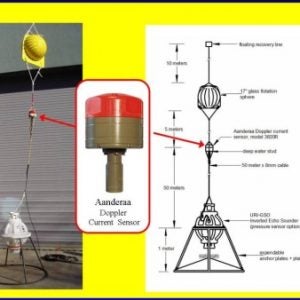Introduction
The Inverted Echo Sounder (IES) is an ocean bottom-moored instrument that measures vertical acoustic travel time (VATT) round trip from the seafloor to the sea surface. With an optional Paroscientific pressure sensor, the instrument is designated a PIES. A combined IES, data-logger, and acoustic release with both Paroscientific pressure and Aanderaa current sensors is called a CPIES(see the schematic to the right). GSO/URI currently produces Model 6.2 IES.
The VATT varies principally due to changes in the temperature profile of the water column. Applications in several large scale ocean currents and frontal zones have demonstrated that VATT can be re-interpreted as geopotential height (dynamic height), which varies due to current meandering and eddies. The IES is well-suited to monitor changes in temperature structure and dynamic height. In many regions the vertical profiles of geopotential height, which vary with time, may be determined from VATT measurements. Data from laterally separated IESs can estimate horizontal gradients in dynamic height, from which geostrophic ocean current profiles may be calculated.
